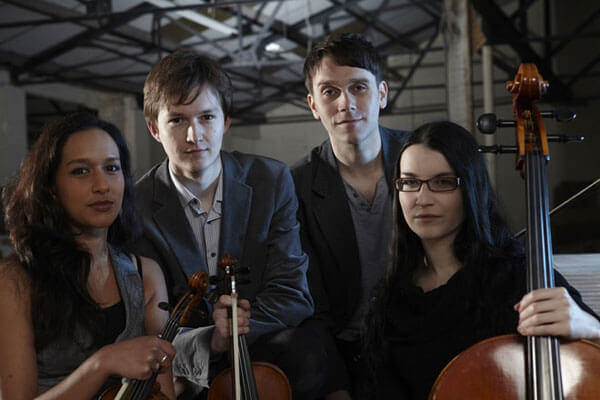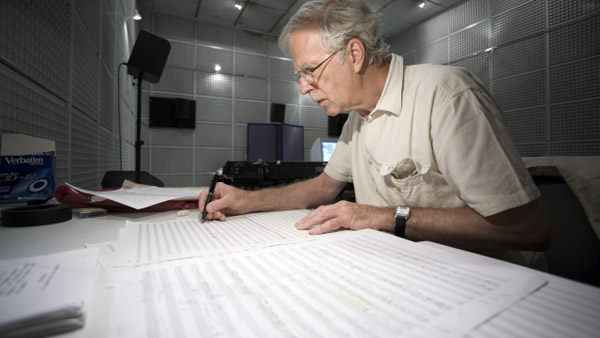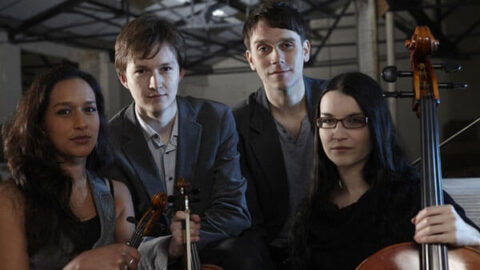 The UK-based Ligeti Quartet is making great strides across Britain, gaining national attention throughout the music scene with repertoire from Philip Glass, Sofia Gubaidulina, Sergei Prokofiev (including his talented grandson), Sir Peter Maxwell Davies, John Adams, and of course, György Ligeti himself. The quartet’s goal is to exclusively champion contemporary works. Those with attentive ears should keep an eye on this dynamic ensemble, which has only been together since January of 2010. The Ligeti Quartet - Mandhira de Saram (violin I), Patrick Dawkins (violin II), Richard Jones (viola), and Valerie Welbanks (cello) - gave its first Park Lane Series performance in Queen Elizabeth Hall at Southbank Centre, London, on 11 January 2013, along with up-and-coming guitarist/composer Paul Norman.
The UK-based Ligeti Quartet is making great strides across Britain, gaining national attention throughout the music scene with repertoire from Philip Glass, Sofia Gubaidulina, Sergei Prokofiev (including his talented grandson), Sir Peter Maxwell Davies, John Adams, and of course, György Ligeti himself. The quartet’s goal is to exclusively champion contemporary works. Those with attentive ears should keep an eye on this dynamic ensemble, which has only been together since January of 2010. The Ligeti Quartet - Mandhira de Saram (violin I), Patrick Dawkins (violin II), Richard Jones (viola), and Valerie Welbanks (cello) - gave its first Park Lane Series performance in Queen Elizabeth Hall at Southbank Centre, London, on 11 January 2013, along with up-and-coming guitarist/composer Paul Norman.

Paul Norman, who was recently awarded the Worshipful Company of Musicians’ Silver Medal, plays an Antonio Marin Montero guitar and is based in Birmingham, where he is completing his Masters in Composition at the Birmingham Conservatoire. The concert featured a mix of works for guitar and for string quartet. The works performed were from composers Joe Cutler, Ed Hughes, Stephen Dodgson, Laura Bowler, Ligeti, and Jonathan Harvey, who sadly passed away in November of 2012.
The only drawback to this performance was the selection of guitar pieces. This is not a complaint about Norman’s playing, as his performance was excellent and magical. But while the three string quartet compositions were just the right length and well fit for this evening, the works featuring guitar were too similar, and too long for the concert as whole.
Joe Cutler’s Guitar Music (2010), the first piece on the programme, played out in three varied sections. A combination of fun and jovial moments, as its marking of “dusty” is developed throughout. The second movement included interesting harmonies beneath a serene group of folk melodies. Movement III, drawing its influence from jazz, blended well its harmonics and melody, as its complement of chords closed the piece in a favorable fashion.

Jonathan Harvey’s Sufi Dance (1977) was short; the composer described it as a “memory of a Sufi song heard some time ago and probably incorrectly retained or at least filtered through his own path of thought.” Its compelling sonorities, based on Sufi cultural influences, featured credible exploitation of retuning, with convincing extended techniques, such as tapping, to create a philosophical landscape. Another Harvey piece followed. His String Quartet No. 2, written in 1988, featured three distinct movements blended into one. The first section featured a repeating cantus firmus melody, disjointed into an interesting pulse of buildups and contrapuntal climaxes. Its second section was dark, separate, and slow moving, with a beautiful melody against stark cluster-like tremolos. The ending was rather hollow, yet serene with its exploration of dense and haunting extended techniques.
Laura Bowler’s Hay Fever was the highlight of the programme, a theatrical impromptu piece based on the final scene from Sir Noël Peirce Coward’s 1924 comedy of the same name. It was commissioned specifically for this event at Southbank. Hay Fever’s dynamic performance was a contrast between improvisation and musical narrative. The quartet became the four terrified guests of the Bliss family, sitting at a table set for a breakfast of toast, fruit, and a pot of tea. Bowler’s approach to the ensemble’s interaction with each other and the audience, combined with their bouncy yet quirky performance, was never tiresome or cliché. Instead, this stimulating juxtaposition of musical performance with acting was clever and unique. This comes as no surprise, as Bowler, artistic director of her own Size Zero Opera company in London, is making great waves both as an opera composer and performer.

Ed Hughes’ Summer Light for solo guitar (2012), a Park Lane Group commission based on four short studies, entailed beautiful arpeggiated textures, intricate diatonic harmonies, and sudden stops in a free toccata, moving tempo. The composer dedicated this work to the late Harvey, based on their collaboration on the latter’s choral composition last summer, giving credit to the soft changing light of the South Downs. This piece ran longer than indicated, and could have been shorter. While it felt somewhat drowned out, it was a very good piece and a heartfelt reflection of Mr. Harvey.
The final guitar piece, Fantasy-Divisions for solo guitar (1969) by Stephen Dodgson, was in six movements, and was written for Park Lane alumnus John Williams. All sections flowed gracefully and without effort from one movement into the other. It employed elements of rapid textures, stark contrasting melodies, exploration of lower pitches of the instrument, serene harmonics and choral movements, finishing off with a full complement of well-known extended techniques.
Concluding the programme was György Ligeti’s Second String Quartet (1968), a trance-like crowd pleasure. The five movements of the work featured all the intrinsic nature of the composer’s work. The opening was complex yet with beautiful stillness sonorities (Allegro nervoso – Prestissimo – Allegro moderato – Ferocissimo). Next, came fluctuations of distorted pitch centers (Sostenuto, molto calmo) followed by interesting pizzicato textures and descending micro-tonal intervals (Come un meccanismo di precisione). A fast and brutal brisk outburst erupted in the fourth movement (Presto furioso, brutalle, tumultuoso), followed by the most enigmatic movement of all (Allegro con delicatezza), a dense resonance of sound with a romantic gesture. As the Ligeti Quartet takes its name from this legendary composer, its no coincidence that the concert ended with this enduring work.
A standing ovation followed, as the Ligeti Quartet and Paul Norman had delivered convincing performances based on a very high caliber of talent and perseverance.
–
Brian Mark is an American composer currently living in London.
























